How to Take Apart and Clean a Stinky Kenmore (Whirlpool) Top Loading Washer
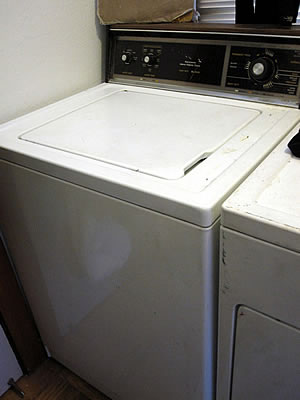 Seems like this is the year for smelly appliances and DIY solutions. A few months ago, it was dishwasher funk. And then recently, we noticed a linty residue on our clothes and a moldy smell coming from the washing machine. (The residue was not laundry powder; we use soapnuts.)
Seems like this is the year for smelly appliances and DIY solutions. A few months ago, it was dishwasher funk. And then recently, we noticed a linty residue on our clothes and a moldy smell coming from the washing machine. (The residue was not laundry powder; we use soapnuts.)
So, how is fixing a washing machine related to plastic? Well, we did end up with some plastic waste during the week-long ordeal. And learning to fix things, in general, is one of my strategies for avoiding new purchases and hence, new plastic. But really, I’m just so tickled that I was able to take the whole thing apart, clean it, and put it back together again, that I have to share!
This post will be long and winding and contain a lot of pictures. Hopefully, it will be funny, too, because who doesn’t enjoy a good washing machine repair story? And since I spent a ton of time on the web looking up parts and procedures and advice, I’ve included a list of all the resources I found at the bottom of this post for quick reference. I’m hoping someone else will find this information useful.
Onward. Here are the steps I took and the challenges I faced down…
1) Causes of white “lint” on clothes. First, I Googled something like “washing machine leaves lint on clothes” and found this great discussion on the Gardenweb forum (which covers more topics than just gardening) and learned that since the advent of the automatic dryer, washing machine manufacturers have stopped adding lint baskets that can be manually removed and cleaned, assuming the dryer will remove the lint. But at our house, we hang all our clothes to dry, so we can’t rely on the dryer. Here are a few steps I discovered to reduce lint:
- a. Separate linty clothes from non-linty clothes. Wow. I never thought of that. I’ve always separated darks and lights (which seems like a no-brainer way to keep light lint off of dark clothes) but apparently, it’s also good to wash linty things like sweatshirts and towels apart from dark clothing as well.
- b. Avoid powdered detergent in cold water. But like I said, we use soapnuts, which are not powder and are not detergent.
- c. If the machine has a self-cleaning filter at the bottom (apparently ours does), you have to take the machine apart to see if it’s actually cleaning itself properly.
2) Causes and solutions for moldy washer smell. Next, I Googled “moldy top load washing machine smell -front” (I excluded the word “front” because it seems that more frontloading washers have this problem than top loading, and the instructions for them are different) and discovered a very helpful discussion of Kenmore Washer Odors on Bob Vila’s Website. From this and other sites, I found these suggestions:
- a) Run a hot water maintenance cycle once a month without clothes, adding a cup of white vinegar to the water. We tried that, and it helped for a couple of weeks, and then the washer started smelling again.
- b) Other suggestions for washer cleaning involved bleach, heavy duty detergents, and mold killer, none of which I want to use. Some posters blame cold water washing and natural laundry cleaners. Well, I’m not willing to use hot water for my clothes (once a month to clean the washer is okay) and toxic detergents, so there had to be a better way.
- c) Several people said they’d taken the washer apart and found terrible black gunk underneath the tub, so after the hot water vinegar failed us, and since I wanted to check that self-cleaning filter anyway, I decided to take the machine apart.
3) Note the model number of the machine. How else was I going to find out how to take it apart? Lift the lid. The model number is on a sticker on the rim of the washer.
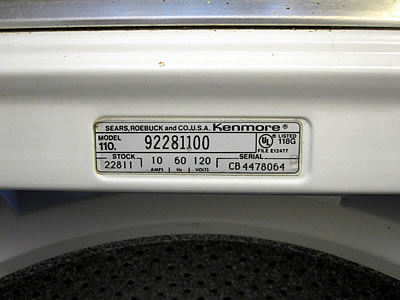
3) Order the DIY Washer Repair Manual. Why? Because even if you still have the Users Guide that came with the machine, it won’t tell you how to take the thing apart. Sears wants you to call their technicians! I found our manual on the Sears Parts Direct website, but tonight, I get an error message when I try to find it on the site. No worries. Turns out, Kenmore top load washers are actually made by Whirlpool, so this Whirlpool washer repair manual will work as well.
The manual was shipped in a plastic mailer. So that’s plastic item #1 for this project.
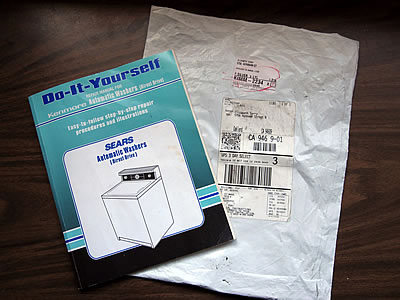
4) Remove the cabinet. You don’t need me to explain this. Instructions are in the manual. And apparently, we didn’t even need to buy the manual because the repair instructions are also online at RepairAve.com and the website ApplianceAid.com has good information about repairing a Whirlpool/Kenmore top loading direct drive washer as well!
What’s more, if you want to see how the machine is supposed to come apart, do the following search on Youtube: “WHIRLPOOL WASHER REPAIR VIDEO” and you’ll find the whole series of videos by Youtube user DIYAPPLIANCEREPAIR that show you exactly how to do it step by step. But beware. The machine that British James uses in the videos is apparently new and works exactly like it’s supposed to. Mine did not.
Anyway, we removed the cabinet, and Michael set it up on top of the dryer because we have so little room in our back hallway.

5) Remove the white plastic ring on top of the tub. Follow the instructions. After I got mine off, I found this gunk on the underside. I cleaned it off in the shower. It’s nothing compared to what we found later.
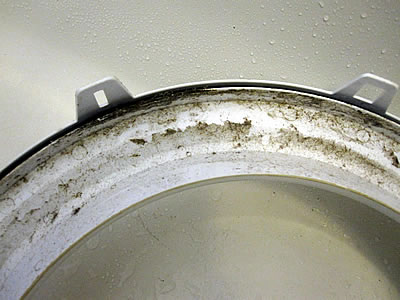
6) Remove the cap from the agitator and remove the nut inside. Fortunately, the nut driver we bought to repair the dishwasher was the right size. It turned out not to be a single-purpose tool after all!


7) Remove the spanner nut. According to the manual, this thing should come off easily with a hammer and screwdriver.
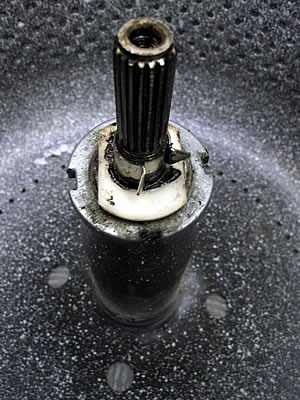

Whoa, Nelly! I tried all day to get that thing off with a screwdriver, and all I did was dent the metal. Michael tried too, pounding and pounding against the screwdriver with the hammer. The spanner nut moved not at all.
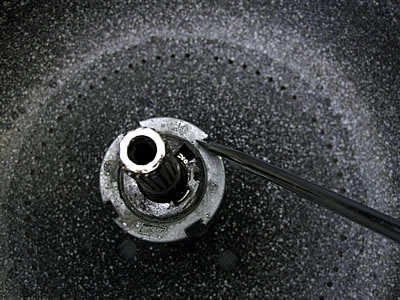
Then, I discovered that there’s actually a special tool made just for this purpose, which I learned about on the Discuss-o-Mat forum. (Okay, so we did need a single-purpose item after all.)
8) If the hammer and screwdriver don’t work, use a spanner nut wrench. We could have ordered one through the mail, but our washer was semi-disassembled, and we needed to do laundry. Michael put an ad on Craigslist to find out if anyone in the neighborhood had one. (Buying used or borrowing or sharing are other methods I use to avoid buying new stuff, plastic and otherwise.) We didn’t find someone with the wrench, but we did get advice about which hardware store to call. The store’s manager directed us to Reliable Parts in Berkeley. (Reliable Parts has a few locations in other states, too, as well as an online store.) Michael was able to ride over on his bike and pick up the spanner nut wrench the very next day.
Unfortunately, the tool came packaged in a plastic bag and was wrapped in a plastic foam sheet. Plastic items #2 and #3.
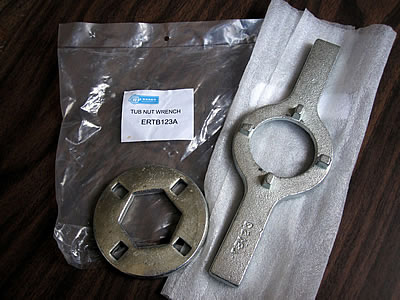
A few taps on the wrench and the spanner nut was off. I was good to go… or so I thought.
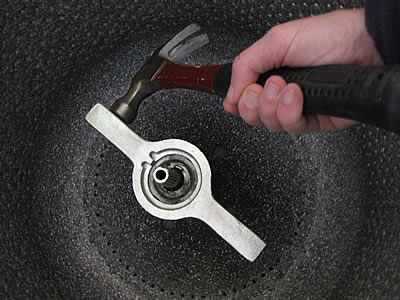
9) Lift the entire inner porcelain washer tub up off the drive block and out of the outer plastic tub.
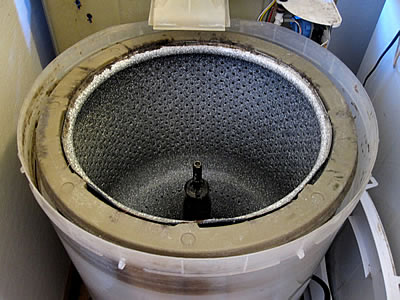
This should have been easy. In fact, witness how easy it is for British James (who, as you’ll see, does NOT recommend getting the spanner nut off with a screwdriver and hammer):
Not so easy for me. I nearly tore my hair out for a whole day trying to pull the tub up. It didn’t budge. It didn’t even hint that it might budge. I wondered if there were screws or something else holding it in place — something that British James failed to mention. Then, I found a whole thread on the Appliance Guru discussion forum about this very thing: Whirlpool Washer Inner Drum Removal.
10) Try alternative methods to remove the washer tub. Members of the forum suggest that years of accumulated crud has cemented the tub to the drive block and that only brute force will move it. Michael’s strong. I could have waited for him to come home. But no way! I hate not being able to do things myself! I tried all the suggestions on the forum: banging a hammer along the drive block, using a screwdriver in gap on drive block to pry it loose, banging and yanking, searching on Google, banging and yanking, searching on Google again. This went on for hours. I was a little obsessed.
I even followed a suggestion on the ApplianceAid.com site to get in the tub and stomp on it. So I did. If I could have taken a picture of myself stomping inside the washing machine, I would have.
Finally, I gave up on Google and used my own brain. I figured that the gunk was probably a mixture of solidified oil and soap. Maybe it would dissolve! First, I tried pouring some white vinegar into the opening between the tub and the drive block. Looking closely, I saw what seemed to be microscopic evidence of debris dissolving. Cool. So then, I boiled water. I poured an entire kettle of boiling water into that sucker.

Then, I yanked. And Holy Mother of Everything Congealed, the thing moved! I danced in my jammies. (Because why wear big people clothes when all you’re doing all day is trying to take a washing machine apart?) And after getting that thing out, this is what I found had been making it stick. Gross, right?
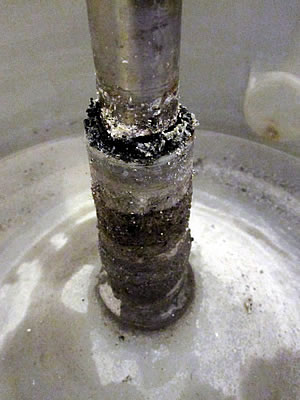
And this is what I found inside the plastic tub:
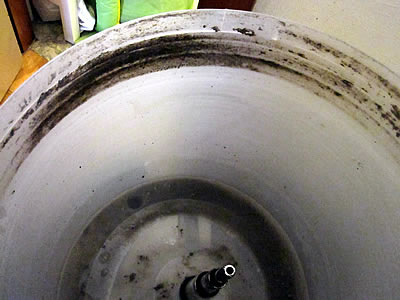
11) Clean the drive block and inside the plastic tub. The task was harder than it might have been because now the tub was all full of water… the water I had poured in to loosen the inner tub. So I got a container and started baling. And when the water was too shallow to bale, I gathered up towels and sopped the rest of it up. Then, I cleaned that drive block with a toothbrush and probably a rag. I can’t remember now. Suffice it to say, you could have eaten lunch off that thing when I was done.
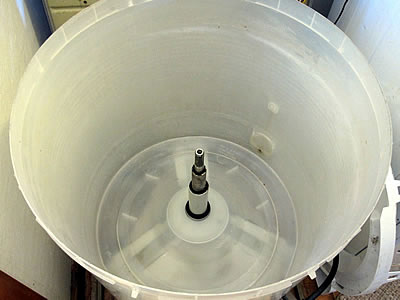
12) Turn the inner tub upside down and remove plastic filter. The filter doesn’t look bad in this picture, does it?
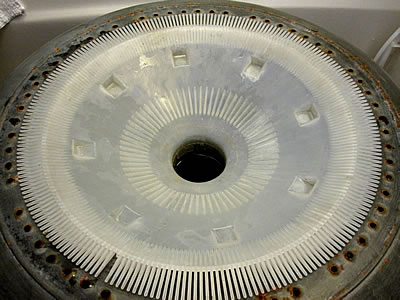
Not until you check out the solidified crud inside that hole: the rest of what was cementing the tub to the drive block.
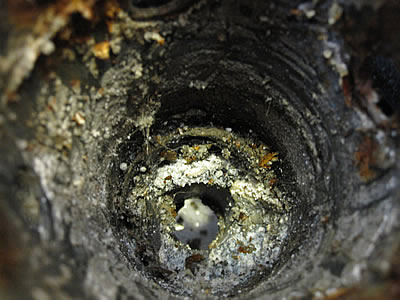
And this is what the outside of the tub looked like. (Imagine how it smelled. Just for a second. Okay, you can stop imagining it now.)
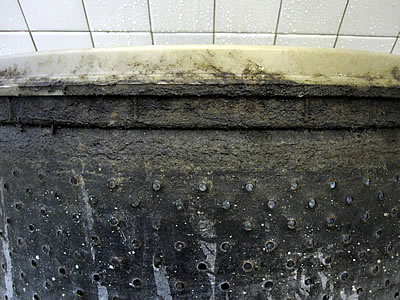
13) Thoroughly clean the porcelain tub. I put it in the bathtub and sprayed it with the handheld showerhead until it too sparkled.

Afternoon snack, anyone?
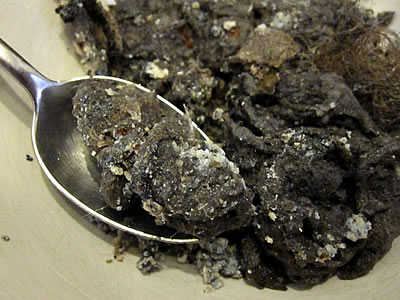
14) Put the machine parts back together. All the nice clean inner parts were easy to put back together, simply reversing what I had done before and without crappy icky crap to get in the way.
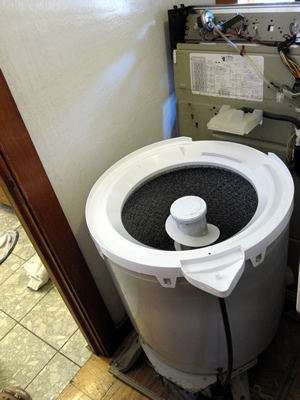
15) Reattach the cabinet, and do some laundry! This part was not so easy. Remember, Michael had put the cabinet up on top of the dryer. He was not here to bring it back down, and I was not strong enough.
Or was I?
It occurred to me that I had gravity on my side. Getting it down would be easier than lifting it up. All I had to do was inch it over near the washer and then try and keep it from dropping too hard. Once the cabinet was on the floor, I did another little happy dance in my jammies. Setting it up on the bottom rail was no easy feat, but I got that done too. And then, I did laundry. Glorious laundry.

Our washer and dryer are old. How old, we didn’t know because we inherited them from our last landlord. But there’s a way to find out! The website Appliance411.com has a Date Search page. Just enter the Brand, Appliance Type, Location, Model Number and Serial Number (both numbers are on that sticker under the lid) and the site will tell you the date your machine was made. Ours was manufactured the week of October 26, 1992. It’s 18 years old and has probably been accumulating nasty-smelling crud for that long. But it’s still going strong, as far as we know. So party on, Garth.
Conclusion
No evil smells yet. I’m separating linty clothes from non-linty. I’m running a cleaning cycle once a month with hot water and vinegar to prevent the buildup from starting again. I should leave the lid up so the tub can air out when not in use, but there’s no telling what could fall in.
The real conclusion in all this is that fixing things yourself (if you have the time and obsessive persistence) is a great self-esteem booster. I highly recommend it, as long as it doesn’t require a needle and thread!
Resources:
Gardenweb forum discussion of lint on clothes
Kenmore Washer Odors thread on Bob Vila’s website
Source for purchasing Whirlpool washer repair manual if Kenmore is unavailable (they’re the same)
Top Loading, Direct Drive Washing Machine Repair Manual online
ApplianceAid.com information about repairing washing machines and other appliances
British James’s Whirlpool washer repair videos on Youtube
Sears Parts Direct website for most Kenmore appliance parts
Reliable Parts source for spanner nut wrench and other appliance parts
ApplianceGuru.com discussion forums
Appliance411.com Date Search to find out age of your appliance
But for information on how I finally unstuck the washer tub from the drive block, you’ll have to read the post!








Hi. Thanks for letting me know about the corrosiveness of the vinegar. May I ask… were you applying it straight or adding it to the rinse water?
This seems like too much work for the price of a new washer! I like that you took this task on and like even more that you shared in great detail every step and every place to acquire information and tools! Just a heads up… I use to use white distilled vinegar in my laundry for things like monthly cleaning and heavy loads like sheets and towels. It really helps to rid musty smells from laundry. But, after a year of using the vinegar, my washer started rusting and the paint started coming off. After researching it on Google and talking to an appliance repair guy I brought in to fix the condenser on my fridge, I learned the vein what is caustic and causing the paint removal and rust! I stopped using it after buying a new washer! Thanks for your great blog! I enjoy most of your articles.
Thanks, Lori Benton! I would never have gotten the tub out without the gear puller. It was a little scary cranking the puller and listening to the tub/block pop as it slowly worked its way loose, but in the end nothing got damaged. I used an over sized fender washer to more evenly distribute the force of the center spindle on the shaft.
I got the puller as a loaner from Advanced Auto Parts which ends up being free once you return it (https://shop.advanceautoparts.com/p/powerbuilt-tools-kit-43-reversible-gear-jaw-puller-kit-648613/9150008-P). Most of the other large parts stores offer this service too. A 6″ puller was a necessity. I tried the 4″ version first but it was too small.
THANK YOU for this post!!! I just finished scrubbing out my 19 year old washing machine and feel like a million bucks. The amount of slime and crud was horrifying! I honestly can’t wait to put it all back together and do some laundry 😁 Your post was a lifesaver; we encountered every single problem you mentioned might occur and were able to breeze right through with your tips. One thing I didn’t realize was how hard it might be to remove the plastic filter on the bottom of the tub; that alone took me probably a good 45 minutes. It was practically cemented on with rust and crud. Thank you again!
I just disassembled my washer yesterday to do this. I didnt pull the drum out though. I jammed my hand between the tub and the spin basket to scrub the crud out. I also took that plastic balancing ring off the top of the spinning basket and cleaned all sides of that. there was some funk hiding behind that ring and the spin basket.
getting that ring back on tight though requires some finesse…. put the ring on loose and then twist as hard and as fast as you can to seat it in place.
then i ran an entire bottle of glisten washer magic through the washer on high fill/speed/hot water and double rinse and all is well in laundry land again.
im going to do this once a year from now on.
Brian
I’ve put in the 3 pots of boiling water the drum still won’t come loose what now????
Keep tapping the drum with a rubber mallet
How do you get the plastic filter off the bottom?!?!
As I recall, I just pried it off.
I just cleaned my nasty stinky washer because of your awesome blog post. Breaking that crust that held the tub in place was hard, but after gobs of wd40, goo gone, and a lot of hot water it finally broke free. This technique is what finally did it. https://www.youtube.com/watch?v=r6iyR8KcqMQ
Thank you so much for posting this!! This saved us countless hours!!
Well that’s a bummer. No new insights. I’ve put vinegar in there, boiling water, boiling water with citric acid activator (dissolves lime deposits), even a bunch of WD40. The tub will not budge 🙁
Maybe try climbing and jumping up and down? 🙂
Rock the tub from side to side. Then do the other side and rock it some more. It will loosen up then you can lift it out. Use a lot of WD-40 and let it sit overnight if it still doesn’t budge. Mine was rusted badly in the tube and the rocking broie the rust loose.
Thank YOU!!! My washer is exactly like yours & all the videos & all the other diy sites couldn’t get that stinkin’ inner tub unstuck. I finally got my 16 year old to get in & rock the boat, as it were. Take a bow! I’m applauding!!! Oh, & the vile, super-nasty mess I found makes yours look pristine. As a house cleaner by trade, I’ve cleaned up some spectacular messes. Nothing comes close to what was hiding in that washer. Paint scrapers, wire brush, hours of scrubbing, Bleach & more Bleach. Still have the heebie jeebies ! Without your help I’d still be fighting that thing! Thanks again!
My washer still fighting back after the boiling water. I took a rest and I noticed that the drive block was going up and down 1/4″ and 1/2″. So I screwed the spanner nut enough to be flush with the drive block and hit it with a hammer 3 times and the basket got loose.
Nice helpful article thank you!
How many pots of boiling water did you use? I’m almost done but the tub won’t budge. I’m getting ready to scream…or cry! I used 2 pots so far but it’s still not moving!!!
You have to keep repeating methods, every other method being another kettle of boiling water! It took me 3 boiling water kettles, then 1 boiling kettle of vinegar, another of water then 3 small boiling pots of water before mine gave way! I’m so thankful for this blog! I did have to get a spanner wrench cause screwdriver and a hammer were just not working. Ha ha, but the guy at the appliance parts store was really cool and offered to buy the ranch back for five dollars after I used it. I told him I’m going to keep it for future maintenance. 😉
We just bought a used Whirlpool Top Loader made in 2007. I tried two different new-fangled washing machines and they are terrible. So, we decided to find something used and as old of a model we could find. However, it has a nasty smell. I did a wash with bleach and detergent, then another wash with vinegar and baking soda. It still stinks. I will try your method next. I am almost certain it is filthy with gunk and could use a good old fashioned cleaning. Thanks for the tips and links!
Wonderful job and great information. All with a sense of humor. Thanks. I had a similar experience with mine. I had reversed the dogs so it would agitate again. That lasted a good while. I ended up taking it apart later for bearing replacement. The slime that was where I could not reach otherwise was scary and mind blowing.
Thank you!!! Your blog post was the one that gave me the nudge I needed to disassemble and clean my beloved but elderly KitchenAid washer. (With loads of help from my husband.) The tip to use vinegar to loosen the tub from the spindle was also very, very helpful. It’s amazing how totally gross it was – and how oddly satisfying it can be, scraping off decades of gradeaux with a putty knife. We also dremelled rust off the upper housing (caused by a liberal and imprecise use of bleach) and painted with appliance epoxy after. And now… it’s CLEAN!! Another appliance saved from the landfill. Thanks again!
What is the upper housing that you are referring to? I have a badly rusted tub spinner base. Is they is the part that you dremeled? I trying to finfld out if it can be saved.
I had a repairman take mine apart. It looked almost identical to yours. Mine is around 12 years old. I have cats so large gobs of hair in nooks and crannies. He said it just happens after so long and there is nothing you can do to prevent it. I never wash filthy rugs or work clothes in my washer, but there was sure a lot of filth in that washer. I admire you for doing your own. It cost me 100 dollars but it was well worth it.
Now this is what a DIY post is supposed to look like! Step-by-step details and pics…great post.
I am wearing my pyjamas and smiling because it’s nice to share this kind of frustration with someone. Thanks so much for taking the time to have documented your experience. Very helpful!!
I watched TONS of videos, and read so many how-to guides about doing this. I stopped and started so many times because I kept hitting road blocks along the way. Nothing I found on any how-to site or youtube was nearly as helpful as this. THANK YOU SO MUCH!
You’re welcome!!! Of all the hundreds of posts I’ve written, this one continues to be one of the top 5 most popular and helpful to people. I never would have guessed.
Hey, thank you for the step by step procedure.. Really nice post with understandable images and content.. You just done an awesome job by having this kind of post.. For Appliance Parts and Supplies like dishwasher, dryer and washer parts etc refer https://www.partsips.com/
Oh my gosh, thamk you for the parts store address. It never came up on my searches for the best prices on parts. They are held the orice of even ebay and Amazon on the spinner base tgat I need. $52.94. It is $96.96 on Amazon most sotes want $120 approximately. This is a lifesaver because its so badly rusted and restoring it will be lot of work. If I can even get the the stem base smooth enough not to distort the seal and leak again. Yippee.
I’m so happy!! I did it and now I have a clean washer for the first time in years. When we picked it up used, it stunk. But we kept the lid open most of the time and that mitigated the ‘odor’, sort of. Finally, I had enough when our towels came out smelling funky over and over. I took my time with this operation because I didn’t want to inadvertently break something. All-in-all, it went about as smooth as I could hope. Alot of work to scrub all the gunk out but now I have a sparkling clean 20+ year old washer. I swear it’s even agitating better. Thanks for putting this online for all us do-it-yourselfers.
Amazing post. I followed your directions, but did not remove the drum. I filled the drum with boiling water and liquid plumber and left overnight. I then ran 2 hot rinse cycles and all the sludge came out of the hose. The clothes that come out of the washer now are more wringed out and don’t smell anymore. This post helped profusely. Thanks a million!!
at one time you could reach in and pull out the filter, clean it and you were done. Well, not you have to take the machine apart. Great for the company to send out a repair man to take your whole machine apart to find why you have lint on your clothes. The old filter in the machine back in a day were doing fine…so they should have let it be. I hate my kenmore. I have nothing but trouble with micro and now the washing machine.
Our 12-year-old washer had started leaving little brown flecks on clothes, and I discovered your very helpful post while searching for answers. Realizing we’d never cleaned it, I was concerned what would be lurking within, since I’d washed baseball uniforms for 6 years (with ground in clay & sand). Our tub ring had layers of caked build-up, and the agitator underside had a goo of clay & who knows what. We never got the porcelain tub out — 3 kettles of boiling water & a quart of vinegar, and that sucker never budged, despite 2 adults yanking & twisting. The top of the drive block got sparkling clean, but we figured the clay had bonded to everything lower down & wasn’t going to dissolve enough to release the tub. Really frustrating, because we could see deposits on the outside of the porcelain tub & in the plastic tub as well. But we cleaned everything else before putting it back together, and are hoping that just getting the gunk out of the agitator might help. If we continue to get brown flecks, we’ll look for a new washer. Regardless of when we do, I now know how to clean it out! Thanks for the great “how to” guide.
Went looking for how to change a washer belt and saw your post. Intrigued by the opening description I read what you offered. Besides being informative it was humorous and I applaud your sticktoitiveness!
I loved this article. Thanks so much for the pictures and the resources and the step by step guide. Awesome
I have a HE Kenmore washer with the dreaded smell. I solved the problem in my prior Maytag by taking it apart and cleaning out all the lint/gunk but I can only get so far in this one with removing drum. Right now I can’t remove the nut at the bottom of the drum – any suggestions? I had it off once a year or so ago trying to find the source of the smell. I finally called a repair man who couldn’t/didn’t solve the problem. He looked at me like I was crazy when I said there is a source to this smell in there somewhere that has to be removed. He said just to run the clean machine cycle with bleach. What bull – that doesn’t get to the source. He apparently tightened that bolt a ridiculous amount before he left. This HE machine doesn’t have the agitator like the older model machines.
Sorry. HE machines are a different breed and from what I’ve read, notoriously stinky. I have no idea how to open it up.
HE (front loader) machines should have the soap dish and door left slightly ajar when not in use and they will NEVER smell or build up mold. Too many people close them after use and they develop mold for that reason. I had them for 15 years without so much as a scent. Liquid Cascade can break down any biofilm in the drum or other parts in both front and top load washers, basically doing what affresh does for $0.30 per application rather than $4 per.
Great article on how to disassemble tub.
I do not know when you posted this information but it sure was helpful. The bad part is I have to tear the washer apart again. That’s what I get for not doing a search prior to doing work. At least I know the ins and outs of tearing it apart and it will not take so long this time.
Thank you! This was just awesome—I also came across this highly instructive video looking for help: https://www.youtube.com/watch?v=hfr-m5iXh3s
I have a W/D Kenmore looks very similar to yours—off to find out the exact year–thanks for that link!!
Too funny, I found your story while desperately trying to get the drum out of my mom’s washer. I had stayed the night and was in my pajamas determined not to let this stupid machine beat me. You were a kindred spirit. I thought of you while I jumped in, hopping inside a washing machine. It was too funny. Between beating, hacking, destroying numerous knives & screwdrivers, vinegar and jumping up and down, then finally my mother and I rocked and yanked with all our might and it moved!!!!! Thank you for all the suggestions.
It’s awesome to have help! Glad you finally succeeded!
Great info. I, too, bought a used washer that was listed on craigslist. I have been using an he front loader for 9 years – no more, if I can help it! I got all the way pulling the inner wash tub out and it would not budge. I even pulled the motor and transmission out. Then I found this blog – working on dissolving the gunk now…..
You have to remove a small metal retaining ring inside of the inner tub.
Thank you, thank you, thank you! I hate wasting money when I can solve problems myself. I was expecting to scour the web to figure out how to clean my washer, but you have it all here. I’m hoping, with my husbands mechanic degree, we can avoid some tool and disassembly issues, and I can get right to scrubbing! Thank you for this! I will definitely be following you!
Thank you. I have the same problem with my beloved 90 series washer. I will not part with it under any circumstances. Now I know I need to call a repair guy to clean as I can’t do this myself. But there is relief since I know this won’t be an expensive part to buy or it’s not forever ruined.
Oh my gosh, it was so long ago, I don’t remember!
I’m really sorry to hear that your attempt was less than successful.
How did it go? Were you able to take it apart and clean it?
I’m glad you were successful!
It’s now March 2015, and the machine is still alive and well!
You have given me hope. I am stuck trying to remove the spanner nut and have used an entire can of WD-40, it seems. I have beat the spanner wrench so hard with the hammer that the nut is stripping and won’t budge. I am going to try boiling some vinegar & water in a pot, now. 🙂
Thanks for the advice. I used boiling water and some Goof Off poured in there, and for me the addition “trick” was to twist AND lift (with my son helping). Just lifting straight up was too hard. The twisting did the trick (after the boiling water ‘n’ stuff!)
Absolutely disgusting discovery ensued…
my four pots of boiling water have, so far, yielded no results. I have also poured in CLR… and attempted to WD40 the heck out of it. Hopefully I am not creating a chemical nuisance in my garage with all of that, but I can literally see the gunk stuck to the outer tub through the semi-translucent plastic and I don’t dare install the thing before I get it clean – because the last thing I want is a pipe/sewer issue because of all the gunk!! I’ll get at it again tomorrow – thanks so much for this post!!
Beth, Thank you for your post on the stinky washer and a step by step repair. Our washer is a Kenmore and is in the same era that your is. We bought it used from an older couples estate sale about 4 years ago. The smell started coming and we tried numerous ways to “clean” it. The drive coupling failed and I had to take the cabinet apart to replace it. I noticed that the top of the outer tank had accumulated grime mixed with dog hair. I wiped out what I could reach with my big hands and thought that would be an improvement. My wife coaxed me to take the washer basket out to do a deep clean. Thanks to your experience and the sharing of it I….we…..have a clean smelling washer again. I have the washer basket and agitator back together in just a few hours. (The spanner nut was a challenge but persistence was the key to get it off with a screw driver and a hammer). The HOT water into the cracks of the washer basket around the spindle did the trick to get the basket out without much more effort than wiggling it side to side.. WOW was the underneath side of that thing cruded up. I took mine outside to clean it. All is shiny clean now, just waiting for the drive coupling to arrive so I can put the washer back in service. Should get another 10 years out of it. Thank you again for posting your experience. I looked around at other things you are doing as well and have been working on ways to cut my new plastic usage down. Bill from Washington State (I’ll be back to see what is new)
Not sure if the funky smell ever came back, but I’ve found running my washer empty with 60 g each of washing soda and borax every couple months prevents smells. (I looked up the MSDS for Affresh and these were the primary components of it, so I save myself the cost and artificial fragrance and just mix my own.)
That’s really interesting about the lint trap. I air dry my clothes, too, and the room where I dry them gets coated in the dog fur a dryer would collect.
Not quite the success I was wanting… NOT because of your tutorial, no…. it’s because somehow I always take possession of things that are possessed! haha. I got all the way down to the Spanner Nut, and everything came to a screeching halt. Mine just so happened to have a locking nut (my father in law even welded me a spanner nut wrench in a couple hours since no where near us had one) and after trying, for more than 5 hours (I really wish I was exaggerating!) we finally said that it’s not coming off, and forcing it may break something and it’s not worth to have to put yet another washing machine on the curb. (this is our 2nd used washer this year…) I did manage to clean the upper ring, and peal off the gunk on the top of the outer basket, but that was about it. 🙁 We fought for a good hour trying to get the cabinet back on… and it’s still not on right…. I’m pretty sure the metal got warped funny when we moved it into the house, and it just won’t sit right. And cleaning out the base near the motor didn’t help with the burning plastic smell we were also noticing… so I think all these set backs happened for a reason… one final push to just buy a new washer. The lint is much less now than before and the smell is less as well. If only my washer would have cooperated…. Thank you again for a great tutorial!
MamaS Wow, five hours! That is some serious dedication. How nice of your father in-law to join in on the operation and weld you a spanner nut wrench, wish I had a welder in the family 🙂 And yes, it does sound like your washer is possessed! Sorry to hear it didn’t work out.
MamaS Ours won’t budge either!!!
MY REFURBISH WASHER THAT WE HAVE HAD FOR ONLY TWO MONTHS HAS ALSO BEEN HORRIBLY STINKY. IVE WASHED THE INSIDE AS INSTRUCTED AND STILL IT SMELLS. WE HAVE NO FILTER WHICH WAS THE ODDEST THING TO ME. MY NEIGHBOR TOLD ME ABOUT THE INNER FILTER ISSUE SHE HAS WITH HER FRONT LOADER. (MINE IS A TOP LOADER) AT HER COMMENT I DECIDED TO GOOGLE THIS ISSUE AND AM DELIGHTED TO FIND YOUR PAGE, WE FX ALL OUR APPLIANCES AS NEEDED. SINCE WE BOUGHT THIS AT A REFUBISHING STORE IT DID NOT COME WITH A BOOK. THANK YOU SO MUCH, I BELIEVE WE CAN SOLVE OUR ISSUE BECAUSE OF YOUR EXPERIENCE. I WILL POST HOW IT GOES WHEN I HAVE A CHANCE TO CLEAN IT.
I love You tube for this sort of thing… I was nearly finished with this post before I realized a female was doing this task… Kudos to you for steppin’ up to this job. I was married to a woman who wouldn’t even watch me mow the lawn or whatever much less do it. Women are supposed to be helpless… You are very special; I hope your husband appreciates your resolve. If you were my wife and did something like this, I would light candles, pour your wine and give you a bubble bath when I got home…. Oh… incidentally, I did learn some things from you. My washer smells a little and I just want to take it apart to clean it like your did…. You’re a babe…. Be well…. Dr. G….
Thank you. I am totally forwarding this comment to Michael.
I’m so glad this post has been helpful to so many people. Hurray for the empowerment the Internet gives us.
GREAT post – very helpful and I can now say, our washing machine is as clean as new. I seriously could not have done it without having found your post – the part about the spanner wrench was the best! Turned out a local appliance repair shop LOANED me one! Guess where I’ll be going next time I need a repair? Ah, who am I kidding, after accomplishing this task, I feel like I can do anything!
By the way – I took my apart outside and took an electric power-washer to it. I can’t imagine how hard you worked to clean out your bathtub after washing your parts, but I’m glad I don’t have that chore to do next.
Thanks for posting – keep up the good work!
hey thanks for your help, i used this to clean the gunk out of my Whirlpool
Great information. I know what my next project is ! Once I get tub out, I think I will take to car wash and hit it with a high pressure hose. Thanks for sharing your story, to help others. Can’t wait to rid clothes of the funk smell !
This was so helpful. We are so thankful for you posting this to help others. Thanks so much
Wait — one problem. The filter piece — how do I get that off? I see the tabs and ring inside, but it’s not obvious to me which piece to press on. There may be too much gunk in between the tabs and the base.
Jennifer, did you get it off? Sorry I didn’t see this post until now. I don’t remember now how I got it off… it was so long ago.
It’s so great to be able to do things ourselves. 🙂
Thank you! Just took apart my top loading stacked washer/dryer to figure out a leak. Your instructions were so helpful! Now a proud owner of a spanner nut wrench for $11. Cleaning the gunk out now and getting ready to reattach the hose that came detached. Feeling very proud of myself for learning how this appliance works that I use constantly. Thank you! Feeling empowered about my laundry.
@Neill Thank you. You have no idea how much your second to last sentence means to me today. 🙂
I repair and resell these Kenmore washers and your idea of the boiling water to loosen the inner tub from the block is something I’d never thought of. Wow, if it works for me I owe you big time. You sould be very proud of yourself doing all this. I’ve been at it five years and I’m still learning. A small electric pressure washer works great for cleaning all the part you mention. Take the maching outside, remove the hose from outer tub to water pump and fire away. Once again you’re awesome for sticking with this. I’ll bet you stick with everything you attempt. don’t you? Cheers, Neill from Oregon
Thank you so much for your detailed story and instructions. Our washer is much cleaner. I think of myself as handy, but your perseverance and willingness to share your experience saved me a bunch of hassle.
Thank you so much! My dad and I sorely needed this info! You’re the best!
fyi- buying the spanner wrench can be avoided. instead of a screwdriver try a 3/8″ socket extension, use the edge of the female end on the part groove and hammer the other end. also they make an adjustable spanner wrench that at least might come in handy for multiple projects. p.s. we love your dedication.
Thanks so much for all this information. I have a stinky Kenmore washer, and after reading your blog, I think it is not a job for me to tackle.
I thought it was just a matter of removing the agitator and cleaning a filter. Duh!!!
I don’t remember this being a problem years ago, so it has to be the detergent and softeners that are causing this problem.
thanks again
In a perfect world, it would be that simple. I don’t understand why all washing machines and dishwashers don’t come with an easily removable and cleanable filter. Could it be because they want you to call in and pay an “expert”?
How did you remove the lint filter from the bottom of the spin basket?
WOW! What a great post, thank you so much for walking us thru this. As others have said I am ready to go home and tear mine apart. My Whirlpool has a terrible odor, I have tried vinegar, bleach, hot water, you name it. My clothes come out fine (I can’t smell odor on them coming out of the dryer – just the fabric softener smell…) but despite leaving the lid open all the time that smell won’t go away, I figured I had a sock stuck in there. Cleaning gloves here I come!
Thank YOU! Your sense of humor regarding this ordeal has helped me through it. We unwittingly began this project in an attempt to see where the mold was seeping into our inner bucket. Another site got me most of the way there, but I stumbled upon your post when we ran into problems removing the inner bucket from the outer. Your vinegar and hot water worked like a charm! And I don’t feel so bad about not realizing this needed to be done to our machines. All this searching helps me see that I’m not the only one!
Beth J., what did we ever do before Google? Glad the post was helpful!
Wow!
Amazing post! This was sooo helpful!! My washer smells absolutely disgusting right now. (I blame my forgetful boyfriend. He ALWAYS forgets about his wet loads of laundry in the washer. UGH!)
Doing a deep clean of the washing machine looks like a BIG project; something I’ll have to do on a day off of work.
I am very thankful you documented your experience in such a funny, informational way!!
THANK YOU!!! now … I shall attempt to do this next weekend …
The end of my stinky story is a surprise!
Before attempting to take apart my washing machine for de-stinking, I pulled it away from its normal position in the laundry room. Underneath I found a drain for the room.
Imagine my surprise (and delight) when a stinky breeze hit my face from that drain! The stink was coming from the drain due to the fact that without water going into it for years, the water in the trap had dried out leaving a direct airway from the sewer to our laundry room. I poured a couple of cups of water down the drain to fill the trap and the air flow stopped. No more stink!
So whenever I would do a dryer load, the dryer would pull air from the laundry room and guess where the replacement air would come from? The sewer!
To prevent it happening again, I ran a small hose to the drain and routed it out from under the washing machine so that from time to time I can pour water into the drain.
Hey Beth – we just moved into a 15 year old condo and when we do the laundry – PEEEEE – UUUUU!
I recalled your washing machine cleaning adventure and re-read it. Though I fancy myself a handyman and, of course, a man of steel…I would rather sit back and read a book than take the machine apart.
What a shame that washing machines aren’t made so they can be easily cleaned, that everything is not made with user maintenance in mind. Right now I am trying the vinegar and praying, rationalizing that I might not be able to accomplish what you did because I don’t have any pajamas to wear.
On re-reading your piece, I’m very impressed by how you do what we all should do – analyze the situation and your own capabilities and proceed accordingly but always with the idea that what you want to do is possible!
We are taught by advertising to be helpless consumers.
Clif, Michael would probably take issue with the bit about my assessing my own capabilities, since he sometimes ends up having to bail me out. 🙂
Thanks for posting the link to repairave.com. I couldn’t for the life of me figure out how to get the top off my washing machine and your link to them was awesome. Thanks!!
I moved into a new apartment shortly after reading this post. I did my first wash and the agitator came out with my clothes! I started to freak out thinking I had a broken washer, but then discovered it was actually supposed to come apart because my washer has a filter! I would never have thought to look for a lint trap before reading this. Now I’m very excited to have a washer with a lint screen since I always hang dry my clothes.
Impressive work!! (I would have found this so satisfying – cleaning up nasty stuff like that makes me feel very accomplished.)
Well done!
Yeah Beth! I had a used and refurbished 1980something washing machine that broke a belt and my husband and I repaired. The only reason we got rid of it is the last time it broke, they didn’t make parts for it anymore! We shipped it off to a scrap metal seller, it’s probably a chair or tin can by now.
Fixing something is empowering, isn’t it? Next time find a job where you have to rent a jack hammer. I got a serious Girl Power rush after using it!
Ah, I remember the good old days of the washing machine lint trap, I personally wish they would build them in again, it would really help reduce the lint build up in the dryer duct. Awesome tut. on how to clean out the washer, I totally want to go home and pull mine apart!
thanks for the list of repair and info links….
Way to go! I’m so impressed!
Wow I am impressed! Perhaps, having your story in the back of my mind, I’ll be more courageous when the time for DIY comes 🙂
this was such a terrific write up that I couldn’t tear myself away. It’s not that I have a thing for stinky laundry gook jelly or anything like that. I’m a Jack of all trades and have pulled many a washer apart for the same reasons you did.
Hurrah Beth! That is EXTREMELY impressive! 🙂 I recently re-caulked and re-grouted my bathroom tiles and now my bathroom looks sparkly new and I must admit that I was VERY impressed with myself and did several of my own jammie dances! I love the satisfaction of DIY! Way to go!
I am beyond impressed…..I don’t think I have it in me. Big pat on your back for a whole lot a DIY work!! And now you have it documented so if it happens again there will be no learning curve! Thanks for sharing-i feel like i was right there with you.
My husband has become an accomplished appliance repair person. And I am super-impressed with him. He’s saved us a bunch of money when our various appliances have been down for the count.
Yay for DIY appliance repair!
My front loader has mold issues. My husband is looking into getting a new seal for it as the mold will not come out of it. I clean it at least once a month but it just won’t totally come off. *sigh*
Nice. I was sorry to have to ditch my last machine but after 30 years of solid use I could no longer get the spare part that broke 🙁
I now have a second hand machine which is about 8 years old and it doesn’t match up to the old one at all.
viv in nz
holy crap! How does all that just keep accumulating and you don’t notice it til it gets horribly stinky? I am going to have to bookmark this for five years from now
That was the best washing machine repair story I’ve ever read! We had a weird smell coming from the dishwasher a while back so I took mine apart to see if anything gooey was in there – (how many times has my fiance heard “Beth from Fake Plastic Fish said…”) Yeah, he thinks I’m crazy, but I got the whole thing back together again and it still works. (Turns out it was a problem with the disposal, but was still good to clean out the filter)
You’ll have to pass the spanner nut wrench around to those who are brave enough to see what’s lurking in their washers!
-J
That’s quite revolting.
I’m with you on the smell thing though. I spent half of this morning cleaning out a gunked-up chicken mash feeder, which I don’t think had been cleaned out for years. It was clogged up with about four inches of solidified mashed up pellet food, and it STANK!
Good on you for fixing the darn thing. So many people would have called the appliance guy, been told “can’t fix that, luv” and gone out and bough a new one.
For some stink prevention in front-loaders, use a rag to dry the plastic gasket all around the front after each use. When we first got out Bosch front-loader, I did a bunch of googling and found this is the most likely source of smells and expensive service calls. The water just wears that thing out and it smells bad as it dies.
I dry the big window and the soap dispenser, too, plus I leave all the doors open between loads. But I have an actual laundry room with a door I can close…I wouldn’t leave the machine open all the time if my kids were little or I couldn’t keep the cats out of the room — too much dangerous temptation!
Thanks so much for this! I have a relatively new washing machine (Bosch front loader bought 18 months ago), no dryer so line dry, and seem to have lint all the time, especially on black clothes (and I wear A LOT of black!) so this was rather timely!
AMAZING!
I would not have gone that far, except by accident. (ie started can’t stop now)
I had an apparent filtre problem in my super fancy all-in-one washer dehydrator.
The water would not drain, so I ran a multitude of cycles of vinegar & warm water, draining with a hose into paint trays from a tiny hose at the bottom of the washer’s front utility panel.
I kept taking it more and more apart until I found that the pump thing-y was jammed by a kiddie eraser I couldn’t get out. And now it was broken, too.
I pulled out a lot of crud along the way, but did resort to a repair tech to replace the broken pump, so running it was the wrong thing alas, except as a learning experience.
You are intrepid!
Brilliant. Subtract the moldy crud (gah!) and add a new motor and I know what you mean. You are brave!
That is AWESOME! That makes me want to figure out how to do a similar cleaning on my front-loader. I know there’s janky stuff growing in there, I just don’t know how to clean it.
I am so impressed! A few months ago the ancient Kenmore left a big puddle on the floor after doing a load. I thought about trying to fix it. Looked and looked but couldn’t find a model number.
So I pulled it out of its place to look at the back, and there was a really nasty pile of black tarry goop on the floor! I don’t really want to think about what was in there! I’m heartened to know that disgusting black laundry machine gunk is not a problem unique to me!
There was also an old sticker on the back of the machine. No model number but it did list the following:
Delivery Date: July 10, 1968!
We are now the proud owners of a brand new space aged top loading LG washer that fits about 4-5 times as much laundry as the old machine in a single load! Seriously, I had to go buy new underwear because it takes so long to dirty enough clothes to fill up a load!
RIP old Kenmore!
Holy Cow! I must admit I stumbled upon this article while searching for unrelated stuff. But this was such a terrific write up that I couldn’t tear myself away. It’s not that I have a thing for stinky laundry gook jelly or anything like that. I’m a Jack of all trades and have pulled many a washer apart for the same reasons you did. And I have to commend you for taking the readers step by step and entertaining us the whole while.
Bravo. Now back to Google I go LOL
WTG Beth!
You have shown that with Google there is no reason folks can’t give DIY a try. Washers and dryers are good subjects to work on because they are big and mostly mechanical with replaceable parts. They usually have clear wiring diagrams somewhere inside should the problem be electrical.
On the gunk – Judy and I have a big water jug we keep in the refrigerator for cold water. We use it almost daily. A while ago I decided to take the top off and discovered the underside was black with mold – we never thought to clean it because we couldn’t see the mold.
Tap water comes with a tiny amount of chlorine in it to kill bacteria but as soon as it is out of the pipes, the chlorine evaporates and mold can form in any standing water. So all those tiny spaces in the washer where moisture can hide are a great breeding grounds for who knows what.
I’ve heard the average lifetime for washers and dryers is 15 years, so you are doing well with yours – and you have to give the plastic parts credit for doing their part for that longevity.
HEY – now that you have the machine looking like new, why not donate it to the National Washing Machine Museum? I’ll bet there isn’t another machine of that age and model in the universe that looks as spiffy. It would be a shame to get it gunky again.
Awesome! DIY is so empowering, and you might have saved that old washer from and early burial at the landfill!
Thanks for sharing! My washer is a Kenmore from 1998. I only get the stinky problems when I forget to take the wash out within 18 hours, but I know we’ve got some hairballs wound around the central drive shaft that need to be cleaned out. This lets me know it’s not something that’s totally out of my DIY league.
One thing I found out is that if your dryer isn’t drying as well as it used to it’s most probably because you need to clean out your dryer vent, which is much easier than taking apart a dryer! I’m scheduling that for once every 6 months now. Not only am I extending the life of my dryer, but I’m also reducing the chance of a fire.
Wow Beth. I have a Kenmore washer circa 1993 (came with the house) and diagnosed the white stuff on clothes problem as related to the internal filter, looked up the diagram for my machine and decided no way was I going to take everything apart to get to the filter. Good for you. I’m still not convinced I’ll be taking the whole thing apart – we don’t have the stink problems.
So far sorting clothes differently and changing the way I wash fleece has solved most of our problems (cold water wash, powder detergent, line dry).
Yeah Beth! My hero! I’m so amazed you literally took it completely apart and put it back together again. Our front loader smells really bad too and it’s less than 7 years old… I will have to check out the front loader sites. I have cleaned out the filter before (that filters before wastewater is pumped out of the machine), and that thing gets clogged with toddler socks and underwear and it sits there moldifying and smells re-heally terrible. Of course, that area is pretty easy to get to.
Holy cow! Now I want to immediately rip apart my washer to see what gunk lurks beneath. Gross! Ours is a little funky too, but we have a Maytag front-loader. Water tends to stay in the tub causing the smell. I have started to leave the door open between loads and run an occasional load of vinegar or tea tree oil through, but it still smells. I wonder what’s hiding underneath???